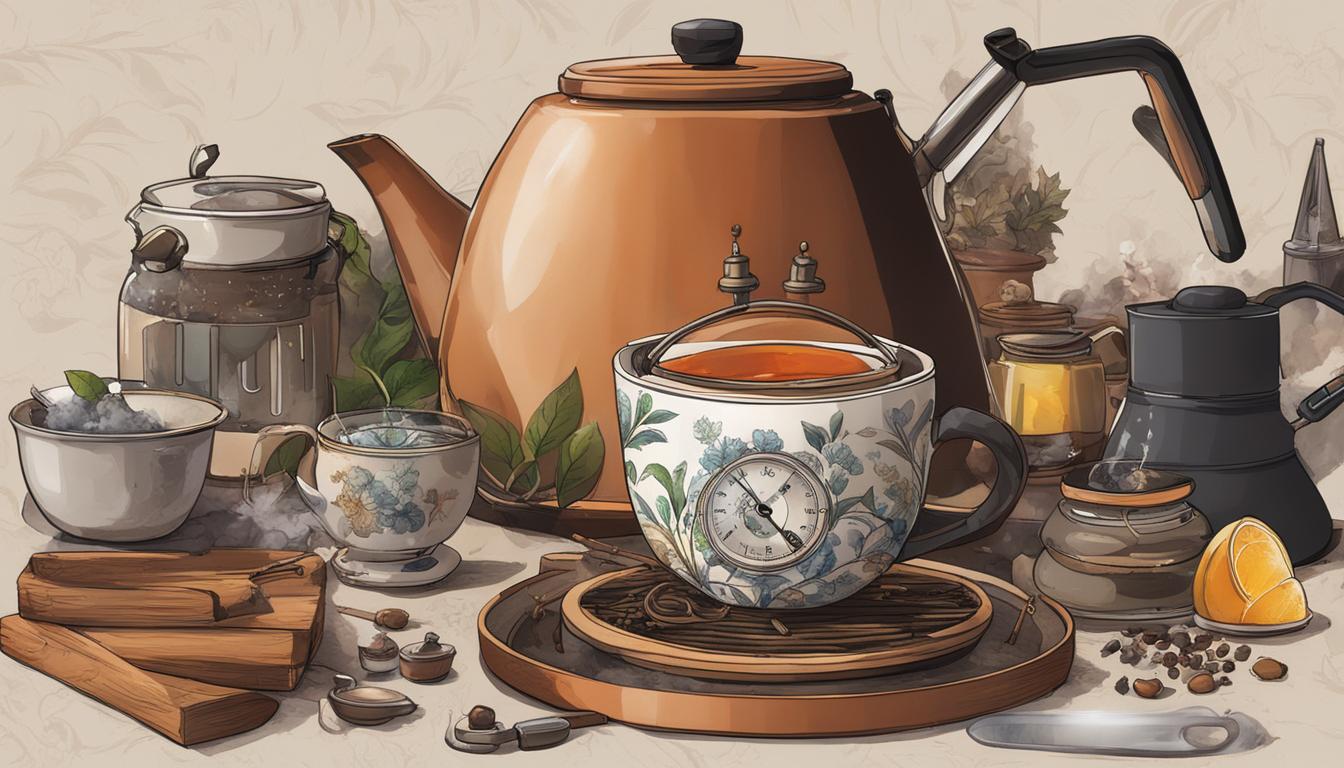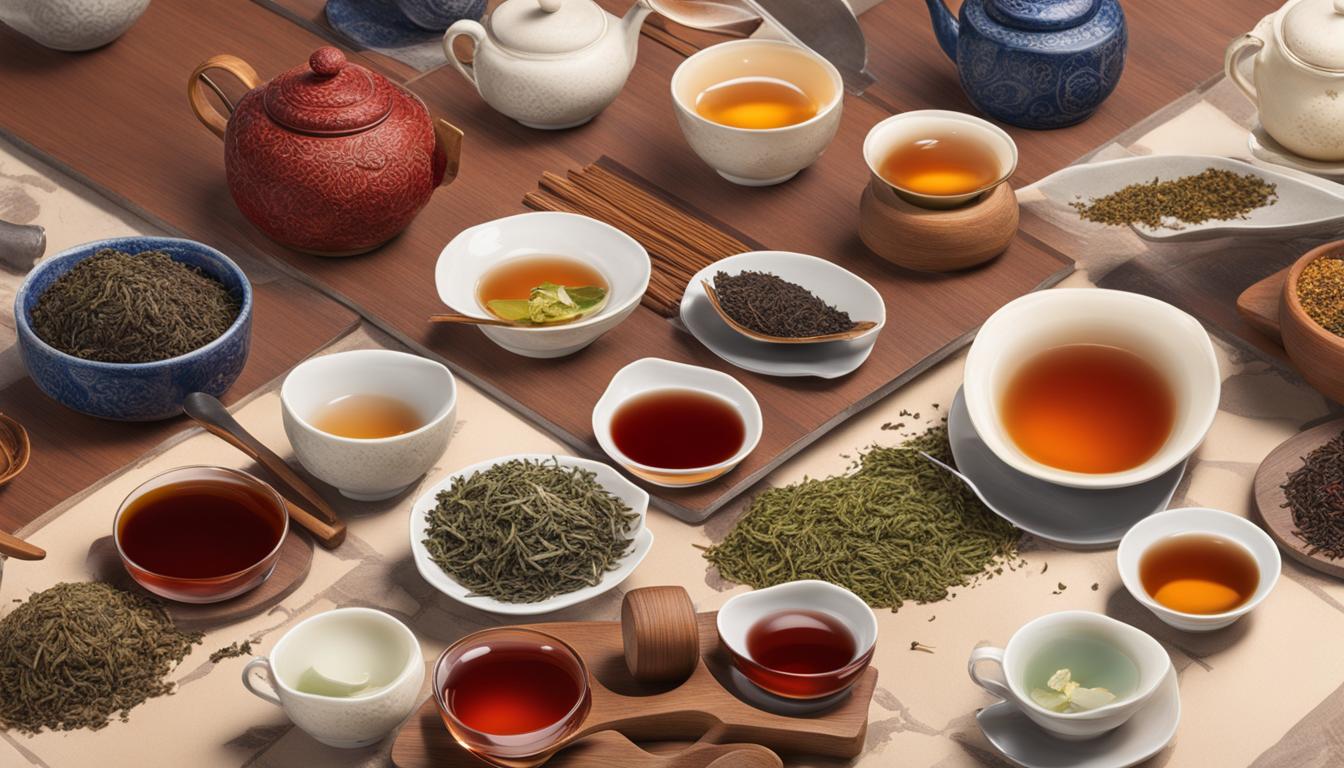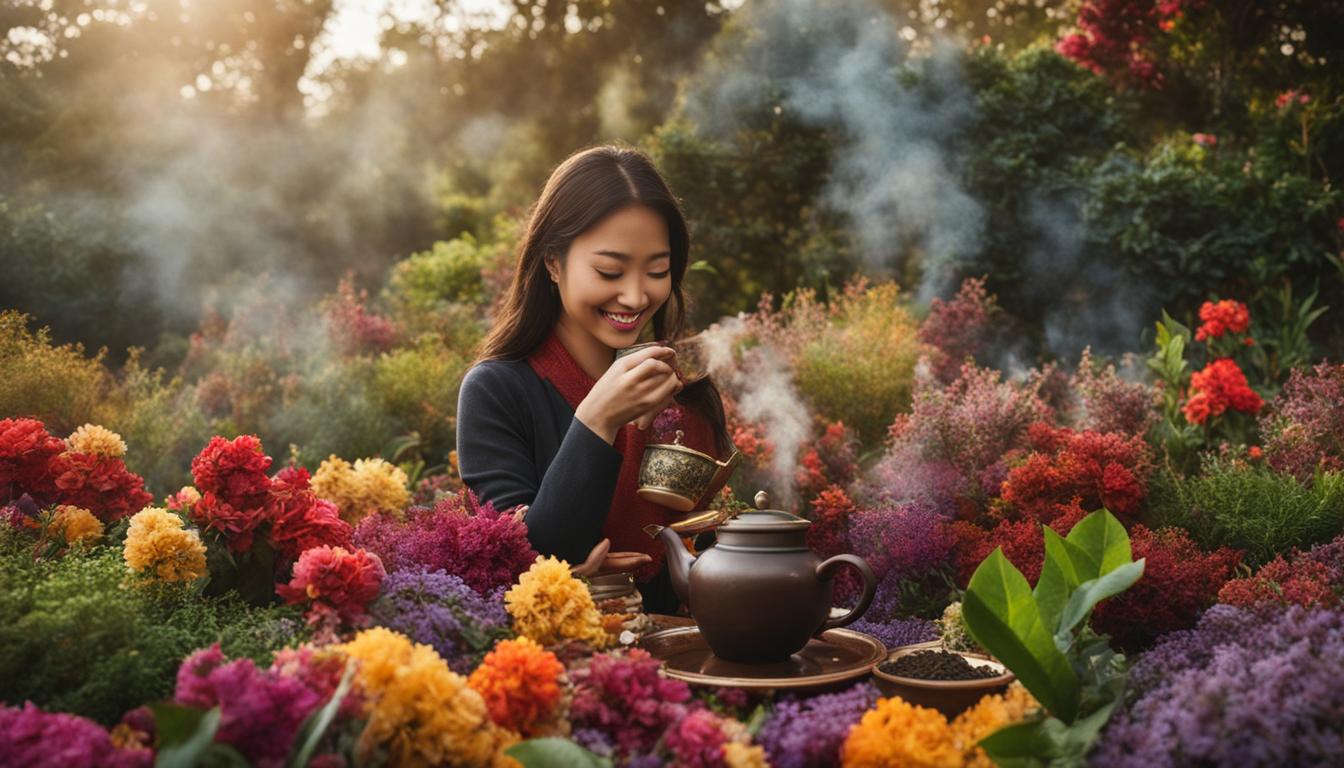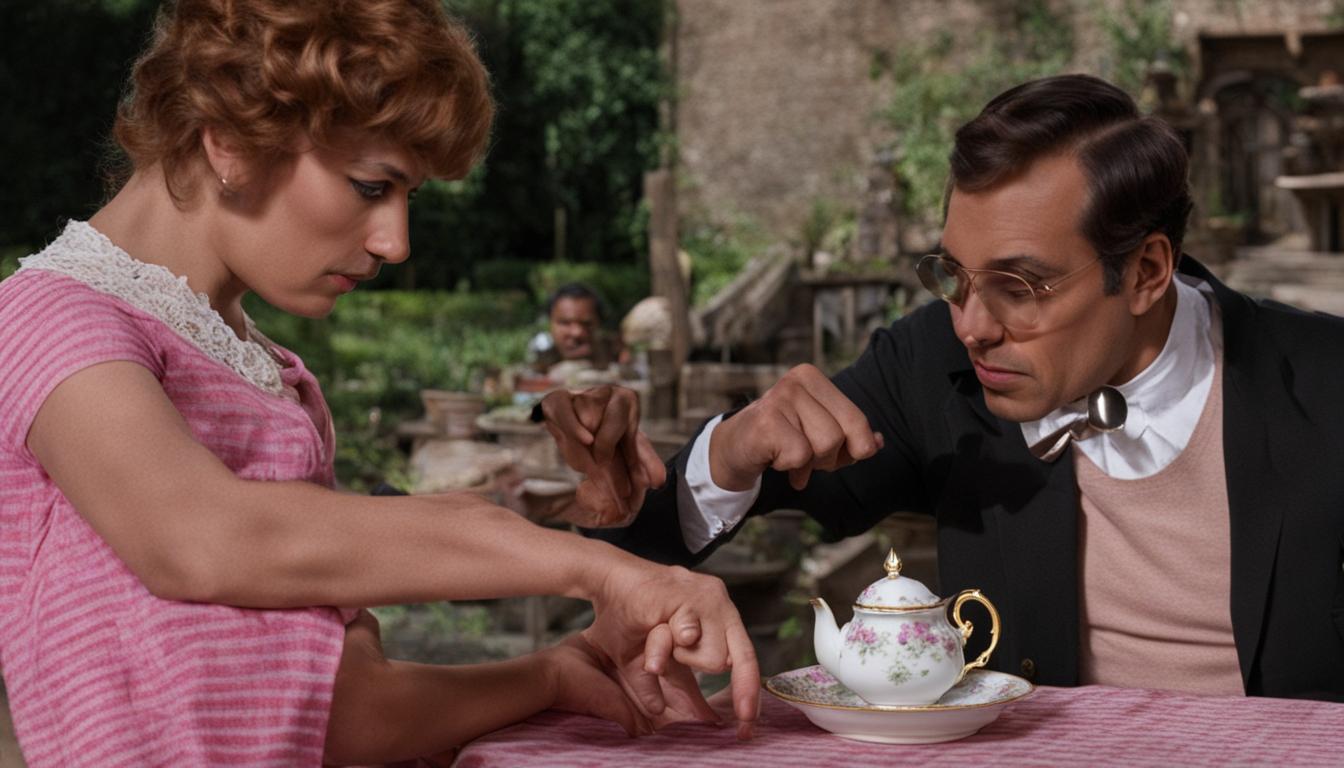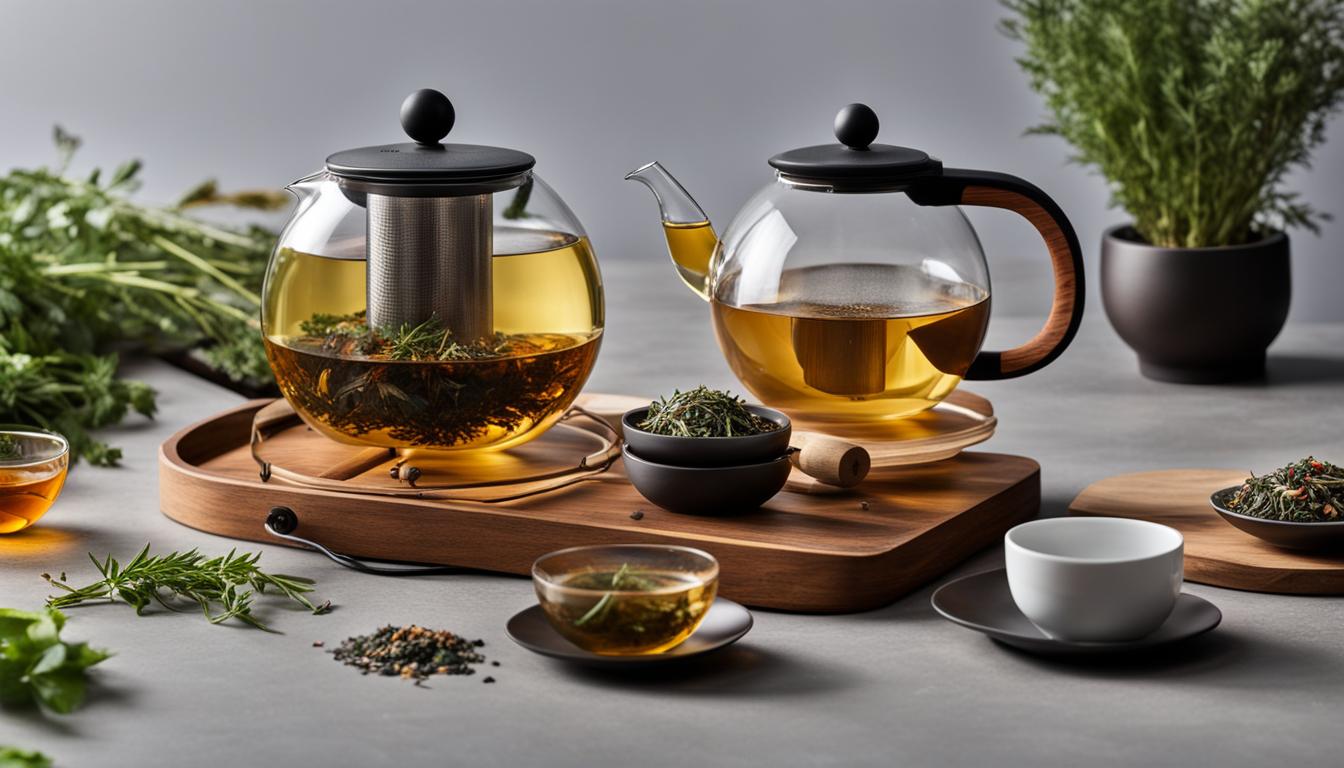Learning how to brew tea can be overwhelming for beginners, but with the right techniques, it can be a simple and delightful process. In this article, we will guide you through the basic steps of tea brewing, providing easy methods for starters to follow. Whether you prefer loose leaf tea or tea bags, we will cover everything from steeping times to water temperatures, ensuring that you can brew the perfect cup of tea every time.
Key Takeaways:
- Mastering tea brewing techniques can make the process simple and enjoyable for beginners.
- Understanding steeping times and water temperatures is crucial for achieving optimal flavor.
- Investing in tea accessories and teaware, such as filters and teapots, enhances the brewing experience.
- Experimenting with brewing iced tea and different types of tea can expand your tea palate.
- Avoiding common tea brewing mistakes and following proper tea-to-water ratios ensures a perfect cup of tea.
Tea Steeping Times and Temperature
When it comes to brewing the perfect cup of tea, steeping time and temperature play a crucial role. Each type of tea requires specific guidelines to bring out its optimal flavors and aromas. Here, we’ll explore the recommended steeping times and water temperatures for different varieties of tea, making brewing a delightful experience for beginners.
Black Tea
Black tea is known for its robust flavor, and it requires a longer steeping time and hotter water temperature compared to other types of tea. Aim for a steeping time of 3-5 minutes with water at almost boiling temperature (around 195-205°F or 90-96°C) to extract the rich flavors properly.
Green Tea
Green tea has a delicate flavor that can easily become bitter if steeped for too long or in water that is too hot. Steep green tea for just 1-3 minutes with water at a lower temperature (around 160-180°F or 71-82°C) to preserve its refreshing taste and aroma.
Oolong Tea
Oolong tea falls between black and green tea in terms of flavor and steeping time. Depending on the type of oolong tea, steeping times can range from 3-5 minutes with water temperatures around 180-200°F (82-93°C). Experiment with different steeping times to find the perfect balance for your taste.
Herbal Tea
Herbal teas, such as chamomile or peppermint, often require longer steeping times to extract their herbal properties fully. Steep herbal teas for around 5-7 minutes with boiling water (212°F or 100°C) to attain a robust infusion of flavors and natural benefits.
| Type of Tea | Steeping Time | Water Temperature |
|---|---|---|
| Black Tea | 3-5 minutes | Almost boiling (195-205°F or 90-96°C) |
| Green Tea | 1-3 minutes | Lower temperature (160-180°F or 71-82°C) |
| Oolong Tea | 3-5 minutes | 180-200°F (82-93°C) |
| Herbal Tea | 5-7 minutes | Boiling (212°F or 100°C) |
Remember to always refer to the specific instructions provided with your tea to achieve the best brewing results. Don’t be afraid to experiment with steeping times and temperatures to find your preferred flavor profile. Happy brewing!
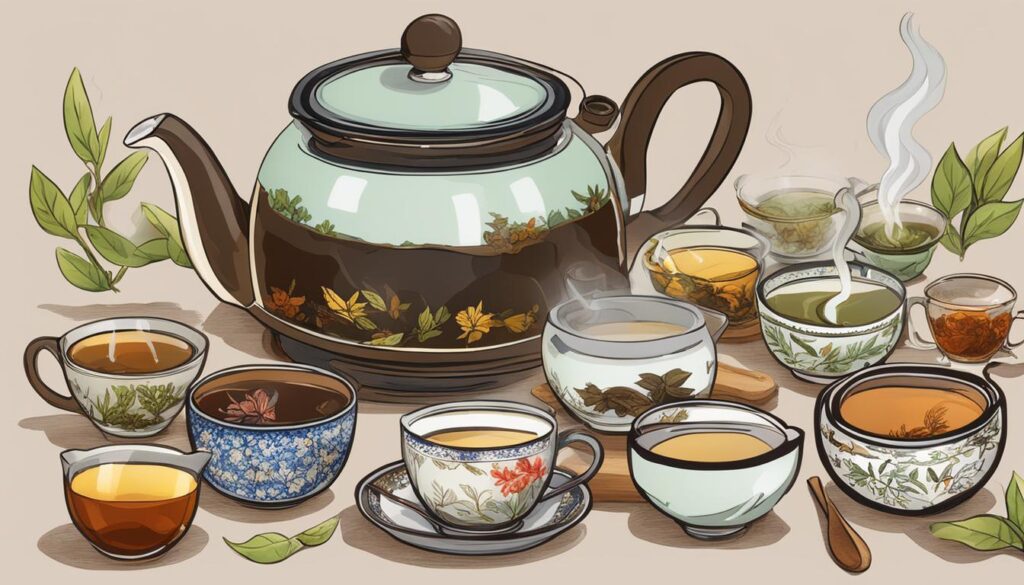
Tea Accessories and Teaware
As you venture into the world of tea brewing, having the right teaware and accessories is essential for a delightful experience. Let’s explore some options that can enhance your tea brewing journey.
Tea Filters and Infusers
If you prefer using loose leaf tea, tea filters or infusers are a convenient way to steep your tea without any leaves floating in your cup. These accessories come in various shapes and sizes, allowing you to choose one that fits your cups or teapots perfectly. Just fill the filter or infuser with your desired amount of tea leaves, place it in your cup or teapot, and pour hot water over it. The filter or infuser will separate the leaves from the liquid, giving you a clean and enjoyable tea experience.
Teapots and Tea Cups
A good teapot can make a significant difference in the brewing process. It should have enough capacity to hold the desired amount of tea and ideally be made of materials that retain heat well, such as ceramic or cast iron. This ensures that your tea stays hot for longer. Additionally, consider investing in a teapot with a built-in infuser, allowing you to brew loose leaf tea directly in the pot. For those who prefer the convenience of tea bags, having a collection of beautiful tea cups can elevate your tea-drinking experience.
Tea Kettles with Temperature Control
To achieve the perfect brew, it’s crucial to control the water temperature. Different types of teas require specific water temperatures for optimal flavor extraction. Investing in a tea kettle with temperature control allows you to heat the water to the exact temperature needed for each type of tea. This ensures that you never brew your tea with water that is too hot or too cold. With this handy accessory, you can explore a wide range of teas and truly appreciate their unique flavors.
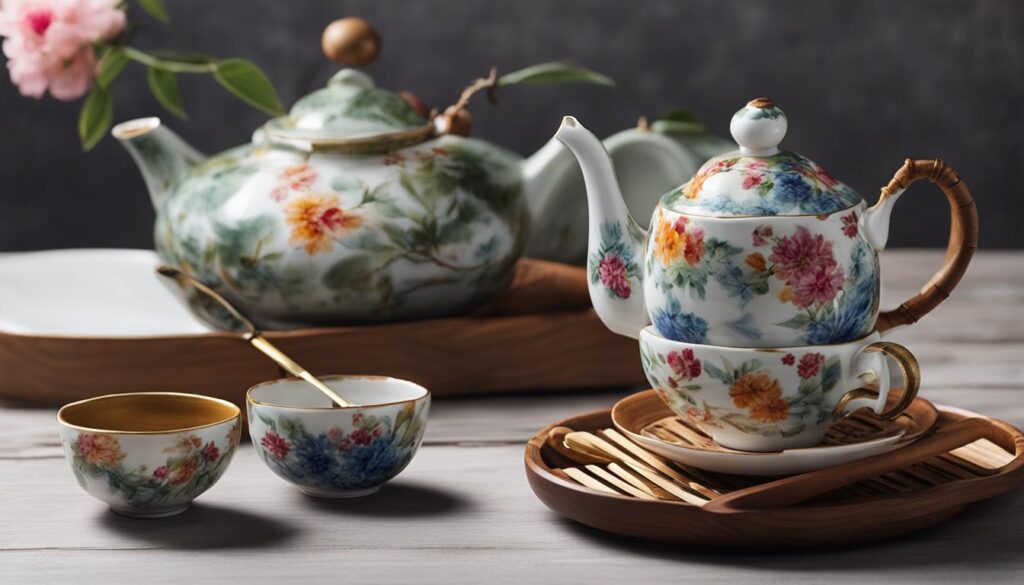
Embrace the art of tea brewing by choosing the right tea accessories and teaware that suit your preferences. Whether you opt for tea filters, teapots, or temperature-controlled kettles, these tools will enhance your brewing process and allow you to savor every sip of your favorite tea.
Iced Tea Brewing and Cold Brew Techniques
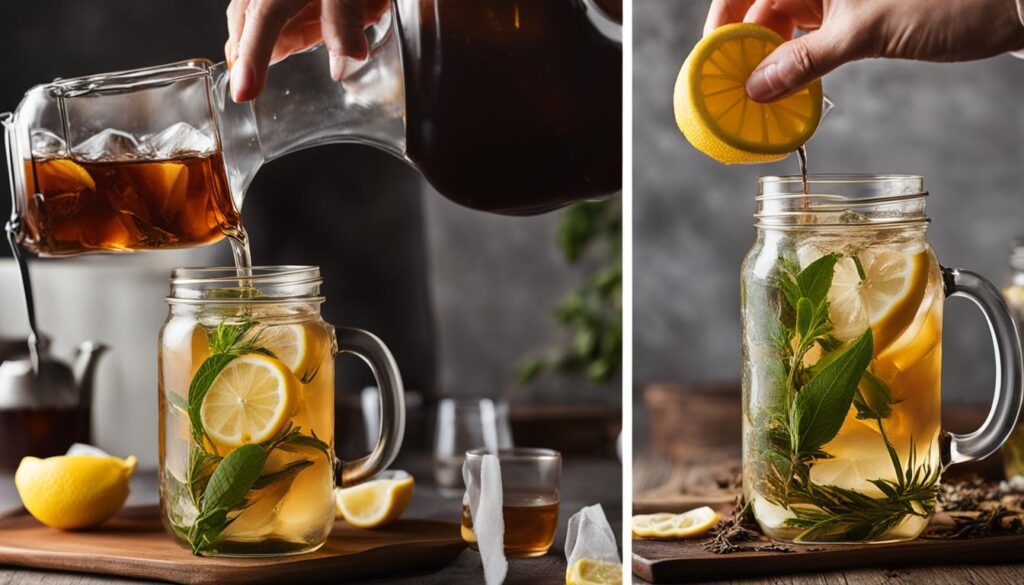
Iced tea is a popular and refreshing beverage, especially during the hot summer months. There are various techniques for brewing iced tea that can help you create a delicious and flavorful drink without diluting its taste. In this section, we will explore different methods for brewing iced tea, including the cold brew technique and quick solutions for when you’re short on time.
Cold Brew Technique
The cold brew method is a simple and effective way to make iced tea with minimal effort. To prepare cold brew tea, you’ll need tea leaves or tea bags and cold water. Simply place the tea leaves or bags in a container, add cold water, and let it steep in the refrigerator for several hours or overnight. The cold water infusion extracts the flavors from the tea leaves slowly, resulting in a smooth and less bitter taste. Once steeped, strain the tea leaves or remove the tea bags, and your cold brew tea is ready to be enjoyed over ice.
Quick Solutions
If you’re in a hurry and don’t have time for the cold brew method, there are quick solutions for brewing iced tea. One method involves steeping tea with hot water and then cooling it down before serving over ice. Simply follow the regular brewing instructions for your chosen type of tea, but use a little less water to compensate for the ice that will melt. Another option is to brew a strong concentrate of tea by using double the amount of tea leaves or bags. Pour the concentrate over ice and dilute it with cold water to achieve the desired strength. Both of these methods offer a convenient way to enjoy iced tea when you’re short on time.
Summary
Brewing iced tea can be a simple and enjoyable process. Whether you choose the cold brew technique or opt for quick solutions, you can create a refreshing and flavorful beverage to quench your thirst. Experiment with different tea types and flavors to discover your favorite combinations. With these techniques, you’ll be able to enjoy a delicious glass of iced tea anytime.
| Brewing Method | Steps |
|---|---|
| Cold Brew | 1. Place tea leaves or bags in a container 2. Add cold water and steep in the refrigerator for several hours or overnight 3. Strain or remove tea leaves/bags 4. Serve over ice |
| Quick Solution 1 | 1. Brew tea with hot water according to instructions 2. Cool down the brewed tea 3. Serve over ice |
| Quick Solution 2 | 1. Brew a strong concentrate of tea using double the amount of tea leaves/bags 2. Pour the concentrate over ice 3. Dilute with cold water to desired strength |
Brewing Different Types of Tea
When it comes to brewing tea, each type requires its own unique techniques to bring out its distinct flavors. Let’s explore how to brew some popular varieties of tea:
Black Tea Brewing
Black tea, known for its robust flavor, requires a slightly longer brewing time and hotter water. Steep your black tea for 3-5 minutes using water that’s just below boiling point. This will help extract the rich flavors and bold aroma that black tea is known for. Experiment with different steeping times to find your preferred strength.
Matcha Tea Preparation
Matcha tea, a finely ground powdered green tea, requires a unique brewing method. Start by sifting the matcha powder into a bowl to remove any clumps. Then, pour hot water (around 175°F) into the bowl and whisk the tea vigorously with a bamboo whisk until frothy. This traditional technique ensures a smooth and vibrant cup of matcha tea.
Oolong Tea Brewing
Oolong tea, known for its complex flavors, can be brewed using the gong fu cha method. This involves using a small teapot and multiple short infusions. Use around 1 tablespoon of oolong tea leaves for every 6 ounces of water. Steep the tea for 30 seconds to 1 minute for the first infusion, and then gradually increase the steeping time for subsequent infusions. This method allows you to appreciate the evolving flavors of the oolong tea.
Rooibos Tea Infusion
Rooibos tea, a caffeine-free herbal tea from South Africa, requires a slightly longer steeping time with boiling water. Brew your rooibos tea for 5-7 minutes to extract its naturally sweet and earthy flavors. You can enjoy it plain or add milk and honey for a comforting twist. Rooibos tea is versatile and can be enjoyed hot or as an iced tea.
By following these brewing techniques for different types of tea, you can fully experience the richness and diversity that each variety has to offer. Remember to experiment with steeping times and water temperatures to find your perfect cup of tea.
Tips for a Perfect Cup of Tea
When it comes to brewing the perfect cup of tea, there are a few common mistakes that beginners should avoid. One of the most significant mistakes is steeping tea for too long, which can result in a bitter and unpleasant taste. Different types of tea have specific steeping times, so it’s important to follow the guidelines for each variety.
The tea-to-water ratio is another crucial factor to consider. Using too much or too little tea can affect the overall flavor of your brew. As a general rule of thumb, use 1 teaspoon of loose leaf tea per cup of water. However, this ratio can vary depending on personal preference and the type of tea you’re brewing.
| Mistake | Solution |
|---|---|
| Steeping for too long | Follow the recommended steeping times for different types of tea |
| Using too much or too little tea | Adjust the tea-to-water ratio to achieve your desired strength |
| Using water that is too hot | Use the appropriate water temperature based on the type of tea |
| Not preheating the teapot or cup | Warm the teapot or cup with hot water before brewing |
In addition to avoiding these common mistakes, there are a few simple techniques that can enhance your tea brewing experience. Preheating the teapot or cup with hot water helps maintain the ideal temperature for steeping. Using filtered water instead of tap water can also improve the taste of your tea. And finally, take the time to savor and enjoy each sip, allowing the flavors to unfold on your palate.
By following these tips and techniques, beginners can brew a perfect cup of tea with confidence and elevate their tea drinking experience. With practice, you’ll develop your own preferences and discover new flavors along the way.
Famous Tea Quote:
“Tea is the ultimate mental and medical remedy and has the ability to make one’s life more full and complete.”
Conclusion
We’ve covered the basics of tea brewing, equipping you with the knowledge to make a perfect cup of tea. But our journey doesn’t end here! It’s important to store your tea leaves properly to maintain their freshness and flavor. To keep them at their best, store your tea leaves in an airtight container away from light, heat, and moisture. This will help preserve their aroma and taste, ensuring a delightful tea experience every time you brew.
And let’s not forget about the importance of keeping your tea gear clean! Regular cleaning of teapots, infusers, and other accessories will not only extend their lifespan but also prevent any unwanted flavors from being transferred to your tea. Give them a gentle wash with warm water and mild soap, making sure to remove any residue or stains. Your tea gear will thank you, and your taste buds will too!
Now that you’re armed with these basic tea leaf storage tips and easy cleaning techniques, you’re ready to embark on your own tea brewing adventures. Experiment with different types of tea, play around with steeping times and temperatures, and discover your own favorite brewing methods. Remember, brewing tea is an art, and like any art form, it’s a journey of exploration and enjoyment. So grab your teapot, select your tea leaves, and savor the satisfaction of a perfectly brewed cup of tea.
FAQ
What is the optimal steeping time and water temperature for different types of tea?
Black teas generally require 3-5 minutes of steeping time with almost boiling water, while green teas should be steeped for 1-3 minutes with lower temperature water.
What teaware and accessories do I need for brewing tea?
Tea filters or infusers are recommended for loose leaf tea, and tea bags can be used for convenience. Choose a teapot that suits your needs, and consider investing in a tea kettle with temperature control for accurate water temperature.
What are some techniques for brewing iced tea without diluting the flavor?
Cold brew involves steeping tea leaves in cold water for an extended period, while another method is steeping tea with hot water and then cooling it down before serving over ice.
How do I brew different types of tea to highlight their unique characteristics?
Black tea requires longer steeping times with hotter water, matcha tea involves whisking powdered tea with hot water, oolong tea can be brewed using the gong fu cha method with multiple short infusions, and rooibos tea requires a longer steeping time with boiling water.
What tips can help me achieve a perfect cup of tea?
Avoid steeping for too long or using water that is too hot. Follow recommended tea-to-water ratios and consider experimenting with different brewing techniques to discover new flavors and aromas.
How should I store tea leaves properly?
Store tea leaves in airtight containers away from light, moisture, and strong odors to maintain their freshness.
How can I clean my tea gear?
Regularly clean teapots and infusers with warm water and mild soap, and ensure they are thoroughly dried before storage.

